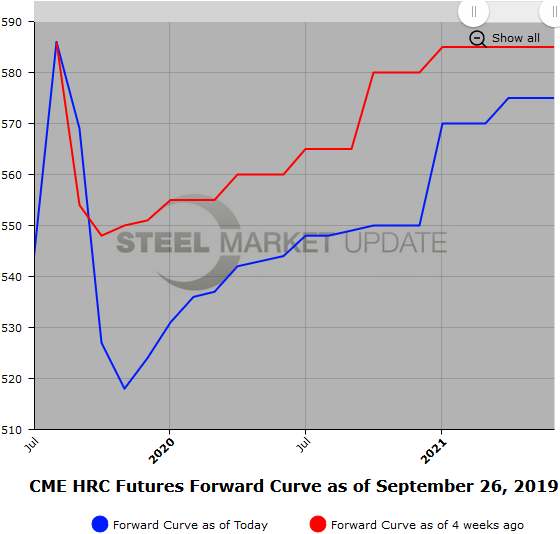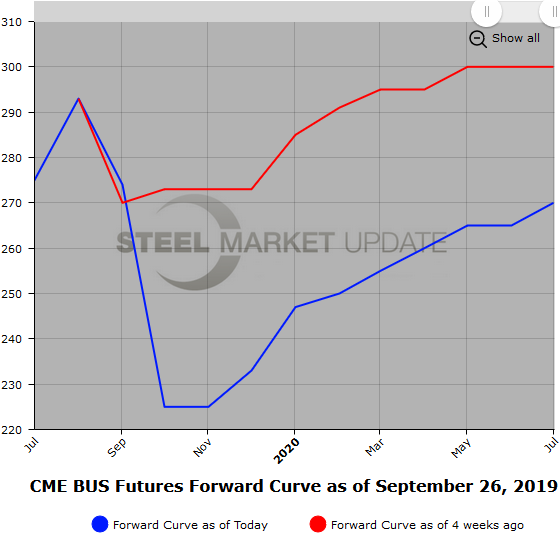Futures

Hot Rolled Futures Prices Continue their Slide
Written by Jack Marshall
September 26, 2019
The following article on the hot rolled coil (HRC) steel and financial futures markets was written by Jack Marshall of Crunch Risk LLC. Here is how Jack saw trading over the past week:
Steel
A $17/ST drop in Midwest HR spot prices as reflected in the decline of the CME August HR average and the September HR average ($586/ST and $569/ST) is overshadowed by a bigger slide in HR futures prices. Since the end of August, settlement values for the HR forward curve have on average declined by about $25/ST. The biggest declines have come further out the forward curve. For the period 30 Aug’19 to 25 Sep’19, Q4’19 HR futures have declined $21/ST, Q1’20 HR futures have declined $15/ST, Q2’20 HR futures have declined $23/ST, Q3’20 HR futures have declined $27/ST, and Q4’20 HR futures have declined $40/ST. In the most active trading months out to Sep’20, the HR forward curve shape is only slightly steeper at $27/ST contango (Nov’19 $548/ST to Sep’20 $575/ST).
We have observed a healthy selling interest in the Q4’19 months recently with some pickup in inquiries for offers in the Q1 and Q2’20 HR futures. Earlier today, Nov’19 HR futures traded as low as $512/ST.
Many participants are sidelined as they wait for clearer signals to enter hedges due to growing concerns: Too much HR capacity, steady to weakening demand, weakening business indicators, soft mill lead times, slackening transport price indicies, declining scrap prices. Hopefully, lower interest rates will start to bite and give this market some much needed support.
Below is a graph showing the history of the CME Group hot rolled futures forward curve. You will need to view the graph on our website to use its interactive features; you can do so by clicking here. If you need assistance with either logging in or navigating the website, please contact us at info@SteelMarketUpdate.com.

Scrap
Early chatter has Oct’19 BUS spot declining by at least $20/GT, which puts it in the mid $230/GT area. This expected softness in prices is reflected in near date BUS futures, which have come under some selling pressure of late. The average BUS futures price drop between 30 Aug’19 and 25 Sep’19 was just shy of $41/GT. The futures curve has gotten steeper with Oct’19 BUS futures valued at a $52/GT discount to the Sep’20 BUS future.
Q4’19 BUS futures were last trading below $235/GT. Volumes have been modest with many potential buyers of paper sidelined given the low current prices as participants wait for a clear sign the market is ready to turn.
Below is another graph showing the history of the CME Group busheling scrap futures forward curve. You will need to view the graph on our website to use its interactive features; you can do so by clicking here.


Jack Marshall
Read more from Jack MarshallLatest in Futures

HR Futures: Market at crossroads after turbulent run
The market appears to be pausing after a turbulent run. But tension remains just beneath the surface. With net long positioning still elevated, sentiment-driven selling could quickly reignite volatility. Still, supply constraints and limited imports are laying the groundwork for a resilient physical market. This moment of calm feels more like a crossroads than a conclusion.

HR Futures: Traders’ views mixed as market navigates tariffs
A look at the HR futures market.

Market pressures trigger HR futures reversal
Market dynamics are shifting rapidly, with futures pricing diverging from physical fundamentals, creating a complex landscape for steel traders.

HR Futures: Correction in market after big rally
Another eventful week in the physical and financial steel markets is coming to a close, but with a markedly different tone than the last update at the end of February.

HR Futures: Market drifts lower on light volume
Over the past couple of weeks, Midwest HRC futures have been drifting lower on light volume. This begs the question if the rally has run out of steam, or is it catching its breath after ripping roughly $150 in less than two weeks? The April CME Midwest HRC future made an intraday high at $976 […]
